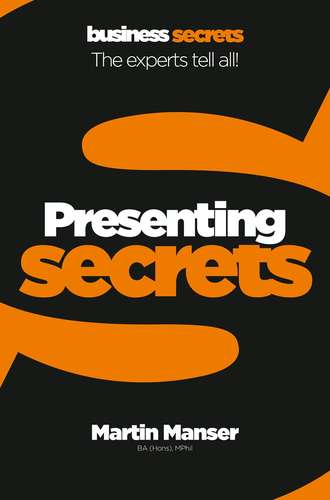
Полная версия
Presenting

Presenting
Secrets
The experts tell all!
Martin Manser

Table of Contents
Cover Page
Title Page
Author's note
Learn how to give the perfect presentation
Prepare the basics
1.1 Stand out from the crowd
1.2 Know your aims
1.3 Know your audience
1.4 Consider how people learn
1.5 Think creatively
1.6 Organize your thoughts
1.7 Research carefully
1.8 Look at your venue
1.9 Consider the seating and accessories
1.10 Plan your stages
Work on your words
2.1 Keep your message simple
2.2 Watch your language
2.3 Vary your style
2.4 Choose your words carefully
2.5 Make clear notes
2.6 Choose a compelling title
2.7 Plan your beginning
2.8 Work out the middle
2.9 End on a high
Plan for props and other people
3.1 Make good use of handouts
3.2 Present tables and charts skilfully
3.3 Freedom is a flipchart
3.4 Master the technology
3.5 Don’t let PowerPoint ruin your presentation
3.6 Try video conferencing
3.7 Work with a team
Prepare your mind
4.1 Give yourself a pep talk
4.2 Build up your confidence
4.3 Manage your nerves
4.4 Practise your presentation
4.5 Be enthusiastic
Interact with your audience
5.1 Break the ice
5.2 Keep the momentum going
5.3 Introduce some humour
5.4 Less is more
5.5 Remember, remember
5.6 Listen carefully
Be aware of body language
6.1 Dress for success
6.2 Stand up and be counted
6.3 Keep eye contact with your audience
6.4 Control your voice
6.5 Pause for thought
6.6 Make a move
Learn from feedback
7.1 Know when to take questions
7.2 Answer questions well
7.3 Deal respectfully with hostile questions
7.4 Have a focused discussion of your presentation
7.5 Evaluate your presentation
7.6 Learn from your mistakes
7.7 Excel in presenting
Jargon buster
Further reading
About The Author
Copyright
About the Publisher
Author’s note
Thank you to Alfred Biehler, Michael and Jeanette Hulcoop, Tim Duffy, Hannah and Brian Murphy.
Learn how to give the perfect presentation
We give presentations to provide information, explain something, present choices, sell a product or service, or persuade others to follow a course of action. Unfortunately, presentations can be dull. But yours doesn’t have to be. I’ve written this book to guide you through every step of the preparation so that your presentation communicates your message effectively and is successful.
My natural temperament is to be shy. Being the youngest of four children meant that I was a listener and generally kept my thoughts to myself. Gradually over the years I’ve come out of my shell and had the courage to express myself. Actually, it’s been a long and at times difficult struggle – and at times I’ve wanted to say something in a larger group but haven’t been brave enough to do so.
I’ve been giving presentations on various subjects for many years now and have gradually become less nervous and more confident. So I want to share with you some of the tips, hints and techniques that I’ve learnt the hard way.
This book consists of 50 secrets of giving good presentations, divided into seven chapters:
• Prepare the basics. If you have a clear idea of your audience and what you want to tell them, you are already on the way to success.
• Work on your words. You need to spend time refining your key messages to make sure they are clear.
• Plan for props and other people. Good use of visual aids can make a huge impact. A picture really can speak a thousand words.
• Prepare your mind. Positive thinking makes a positive difference. It’s normal to be nervous; you don’t need to be afraid of fear.
• Interact with your audience. Remember you’re giving a presentation, not a speech. An effective dialogue with the audience will ensure that you are giving them what they want.
• Be aware of body language. Research has shown that body language is an important factor in a successful presentation.
• Learn from feedback. Whether you are an experienced presenter or a first-timer, there is always more to learn.
If you follow these 50 secrets, you will know everything you need to deliver a brilliant presentation. Your audience will remember your message and, just as importantly, they will remember you.
Whether you are an experienced presenter or a first-timer, you can make a positive impact on your audience and, just as importantly, enjoy doing so!
Prepare the basics
The success of your presentation will depend on preparation. This chapter explains the firm foundations you need to lay to make your presentation effective. It covers creative thinking, organizing your thoughts and undertaking research. This is the ‘blank canvas’ stage. You need to work through the ultimate aims of what you are planning to achieve. Think about who is in your audience and the best way to communicate with them.
1.1 Stand out from the crowd
First of all, take a step back from thinking about the content of your presentation and think about your own personality instead. Remember that your audience will be listening to and looking at a presenter as much as a presentation.
You don’t want simply to deliver a series of data and facts. You want to put your soul into this presentation, and enjoy yourself in the process. The most interesting, memorable and effective presentations have the personality of their presenter stamped all over them. You want to put across your values and opinions, and your audience wants to hear them. Here are some tips to help you from the start to develop a really positive, creative view of yourself as an interesting presenter:
• Read something worthy. Devour your favourite website. Read a quality newspaper e.g. The Economist, Time, Newsweek.
• Think. Don’t just read. Think through the big underlying issues. Schedule in time to relax your brain from concentrated action. Carry a pen and notebook with you, or digital equivalents. Jot down your thoughts and ideas – however odd they may be. They may be useful.
“Don’t measure yourself by what you have accomplished, but by what you should have accomplished with your ability”
John Wooden, legendary basketball coach
• Really listen to people. What they’re saying…and not saying. Reflect on what you’re learning. Talk with friends and colleagues. Discuss issues and ideas; express your latest thinking to gauge responses. Develop ideas you feel passionate about.
• Examine your values and principles. What motivates you? Life is full of decisions. What spurs you on?
• Care for others. Don’t become so absorbed with yourself that you neglect people around you, in your community and in the wider world. Take a stand on world issues, and engage in some practical action.
• Stretch yourself. What areas of life that are currently weak do you want to develop? Sketch them out and then begin to work on the next steps to fufil them.
• Don’t take yourself too seriously. Watch TV. Relax – and laugh at yourself.
• Cultivate your spiritual/emotional side. Whether it’s religion or poetry. We’re not just thinking machines.
• Work on the physical side of your life. Take control of your life. If you’re out of condition, go to the gym regularly: if you want to lose weight, join a slimming class.
Cultivate a positive attitude about yourself as a great presenter.
1.2 Know your aims
It’s vital to know why you are giving your presentation. It is important that you define the purpose of what you are presenting in one sentence. This will clarify what you should include – and what you can safely leave out. Having a concise, clearly expressed aim in front of you in all your preparation will help guide your thoughts.
Think why you have been asked to give a presentation. It may even be that a presentation is not the only way (and possibly not even the best way) of communicating a message.
See your presentation as one part of an aspect of the communications of your company or organization. Other ways of giving a message include email, the company intranet, a memo or report, posters, group discussion, one-to-one meetings, managers and bosses
one minute wonder In preparing a presentation, it can be very helpful to think of one typical person in the audience. Will he or she understand what you are saying and be persuaded by its message? Imagine you are talking to a personal friend.
“If you don’t know where you are going, you will probably end up somewhere else”
Dr Laurence J. Peter and Raymond Hull, authors of The Peter Principle
who model certain behaviour to build trust. Ask the following questions about your presentation:
• Who is in the audience? What are they like? What do they already know about the subject? You can then make sure that what you are saying is suitable for their level.
• What are the main messages? Are you clear about the essential information and ideas you want to communicate?
• What do you want to achieve? This is what you want people to do or think, understand or accept as a result of your presentation. Do you want colleagues to accept future sales forecasts? Or be persuaded to adopt a new product? How will you measure people’s reactions to know whether you have fulfilled your aim?
• How are you going to make your presentation? For example, how formal is it? Will you stand or sit? What visual aids will you use?
• How long will you speak for? Will there be time for questions? What is the room like? How will the audience be seated?
• What’s the big picture? Where does your presentation fit into the overall picture of communications in your organization?
Work out exactly what you want to achieve with your presentation.
1.3 Know your audience
It’s important that the focus of your presentation is your audience. You should do all you can to research your audience so that you can pitch at the right level. Here are eight things to think about.
1 How many people will be at your presentation? The way you give your presentation will vary greatly if the audience is five people, 20, or 200.
2 What does the audience already know about the subject? If you don’t know, ask the organizer. Knowing this will enable you to decide whether to go over the basics and how much you will need to explain jargon.
case study Adam’s failure was when he presented the keynote speech at a major conference. He knew that the company had paid a lot to secure the keynote slot, and he therefore assumed incorrectly that he had to do a hard sell. In reality, the audience was a group of distinguished analysts, and they were interested in industry trends. They reported later that the company still didn’t understand the enterprise. What Adam should have done was simply inform them of the trends the company sees, and that would have built credibility and even positioned the company as market leader.
3 What are the attitudes or feelings of the audience likely to be towards the subject you are presenting – and to you?
4 What expectations does the audience have of you as the presenter?
5 Do members of the audience know one another? Do they have good relationships with one another?
6 Will members of the audience be present because they have to come to your presentation or because they want to be there?
7 Are there any hidden agendas or underlying tensions that you should be aware of?
8 Who are the decision makers in the audience? What are their opinions?
Find out as much as possible about your audience in advance.
1.4 Consider how people learn
People learn in different ways. If you want to communicate effectively, you will vary the ways in which you present information. As a presenter, you should put yourself in the place of members of your audience. If you want to be sure of success, you should remember that people learn in different ways.
There are three main kinds of learning style:
1 Visual learners. Such people like to see information in pictures, diagrams, charts, tables and in writing.
case study Peter led a workshop on communication at which his wife was present. She pointed out to him during a coffee break that some members of the audience were losing interest and motivation. “Get them involved,” she advised. Peter followed her advice and adjusted his method for the next section from presentation to role play: he divided the audience into three small groups which each took different parts. The result: a more highly-motivated audience and more effective learning.
2 Auditory learners. Such people like to listen to information and then discuss it with others, listening to what others say, to help them learn.
3 Kinaesthetic learners. Such people like to be active and learn by doing.
In your preparation as presenter, you should be aware that people learn in different ways. Good presenters will use a multi-sensory approach to include different styles of learning so that every member of the audience will be able to take in the presentation effectively. This means that you should provide visual aids that illustrate and give headings to support your argument, provide opportunities for discussion and make room for expression through stories and role play.
In your preparation, explore different ways to make your presentation more effective.
1.5 Think creatively
Once you are clear about the aims of your presentation in your own mind, you are ready to move on to the next stage, which is to think creatively. Time spent thinking is not wasted: it will mean that your final presentation is clearly structured and easy to follow.
The best way to think creatively is to write about your thoughts in a pattern diagram sometimes called pattern notes, or Mind Map™. This is a creative diagram you draw that captures all the main aspects of your central thoughts as you see them. To do this, you should:
• Take a blank sheet of A4 paper, arranging it in landscape format.
• Write the central thought or theme (a word or a few words, not a whole sentence) of your presentation in the middle of the paper.
• Write around that central word other keywords that relate to it.
• Keep branching out, adding other points that come into your mind.
one minute wonder Acronyms can be a creative way of organizing thoughts and messages. Consider this TOWER acronym for the task ahead: T: thinking O: organizing your thoughts W: writing a first draft E: editing and R: revising the grammar.
“What is the hardest task in the world? To think”
Ralph Waldo Emerson, philosopher
• If you get stuck at any point, answer the question words: who, why, where, what, when, how. These will stimulate your thinking.
• At this stage, do not reject any thoughts. (Use an eraser sparingly to delete what you have written.)
• As a next stage you can draw lines to show the links from your central thought to your key words and between individual key words.
• You can colour in different key words to show which ones are related.
• You can number the different key words in order of importance. Later on, as you deal with each aspect in your writing, you can put a line through each one.
As you draw a diagram of your own thoughts, you will probably see a clear structure with key messages beginning to emerge. (If this doesn’t happen, leave the paper for a while and come back to it later.) Aim for between three and five key messages in your presentation. If you have more than five, you risk overloading your audience with too much information.
Time spent thinking creatively is not wasted.
1.6 Organize your thoughts
Spend time focusing on the key messages that you want to give in your presentation. Begin to arrange your key messages in a logical order. Having a clear structure helps your audience follow what you are saying more easily.
There are several different ways in which you can arrange the information that you want to present. You need to choose the best approach, depending on your audience. If you are unsure which way to adopt, discuss it with a colleague.
1 Move from facts to a conclusion. The audience listens to your presentation of the facts and they are led to a conclusion. If you follow this approach, the audience may have to think hard to follow your logic.
2 Start with a conclusion, then see how that conclusion is supported by certain facts and arguments. This is usually easier for audiences to follow than 1.
“Everyone gets so much information all day long that they lose their common sense”
Gertrude Stein, writer
3 Persuade people to adopt a point of view, by giving different sides of an argument. Begin by stating your opinion, then give the arguments for and against that opinion and finally draw conclusions from what you have said.
4 Give a list of options. Begin by stating a particular situation and then present the various possible solutions, with their advantages and disadvantages. Finally, outline the next possible steps.
5 Explain a process. Begin by stating how many steps are involved in the process. Say how each different stage works, with its end result. Summarize often. Often, a diagram will help clarify the different stages.
6 Include clear signposts of the route of your presentation. For example, “To start with; I will describe two different kinds of problem; on the one hand…, on the other…”.
Spend time focusing on your key messages.
1.7 Research carefully
Inject your presentation with supporting evidence that will reinforce your key messages. Use a range of sources to investigate your subject. You might not use all the information you collect, but you will have thought through different issues.
Sources of information include:
• Data and statistics.
• The Internet. E.g. Wikipedia or www.Credoreference.com
• Libraries. In our digital age, it is easy to ignore the valuable hard-copy resources of libraries that have been built up over the years. Librarians themselves also have a wealth of knowledge at their fingertips and will be able to point you in the right direction. Reference sections of
case study I was once given just three hours’ notice to give a 45-minute presentation, and that included breakfast and travelling to the venue! Fortunately, the subject was close to my heart. I’d kept notes on treatments of similar subjects and could find them easily. I used a colleague’s outline and structure as a basis and added my own personal anecdotes and approach. The keys to success were mental prepararation and being able to access vital information quickly.
libraries are an obvious source of information, while some people find that even a children’s book on a subject provides a useful overview.
If you give many presentations, then it can be useful to keep an ideas book, either physically or digitally, of interesting items that could help you. Such items could include:
• Newspaper cuttings
• Extracts from journals or magazines
• Illustrations that are particularly striking
• Titles of books
• Quotations from public figures or leaders in your field
• Witty anecdotes
• Extracts you come across in your general reading
• Insightful comments in a blog
In your preparation be willing to think outside the box. Explore different perceptions of a sensitive issue. Distinguish between facts and opinions. Question well-known arguments. Go beyond face value.
Inject strong supporting evidence into your presentation to reinforce your message.
1.8 Look at your venue
We’ve all known times when a good presentation has been spoilt by poor attention to practical details, for example when the speaker arrives late or speaks for too long. Do your best to make sure that nothing can go wrong. When thinking about your presentation, consider the details of the venue.
You need to think about the practical details of where you are physically going to give your presentation.
• How will you reach the venue in good time? If you don’t know the location of where you are speaking, work out how you are going to get there. Check the location on a map or check the postcode for your
case study Sarah once led a two-day seminar in Chicago. She booked into the hotel the evening before the first day and in the morning rang for a taxi to take her to the venue of the seminar. The taxi turned up fine and the first day of the course went well. She thought the same would happen the second day but she hadn’t reckoned with the weather. On the morning of the second day it was raining heavily and all the taxis were busy already. She eventually arrived very late for the seminar – even at the point when some of the delegates were wondering if she’d ever arrive at all. The lesson: now she always books a taxi the evening before a presentation.









